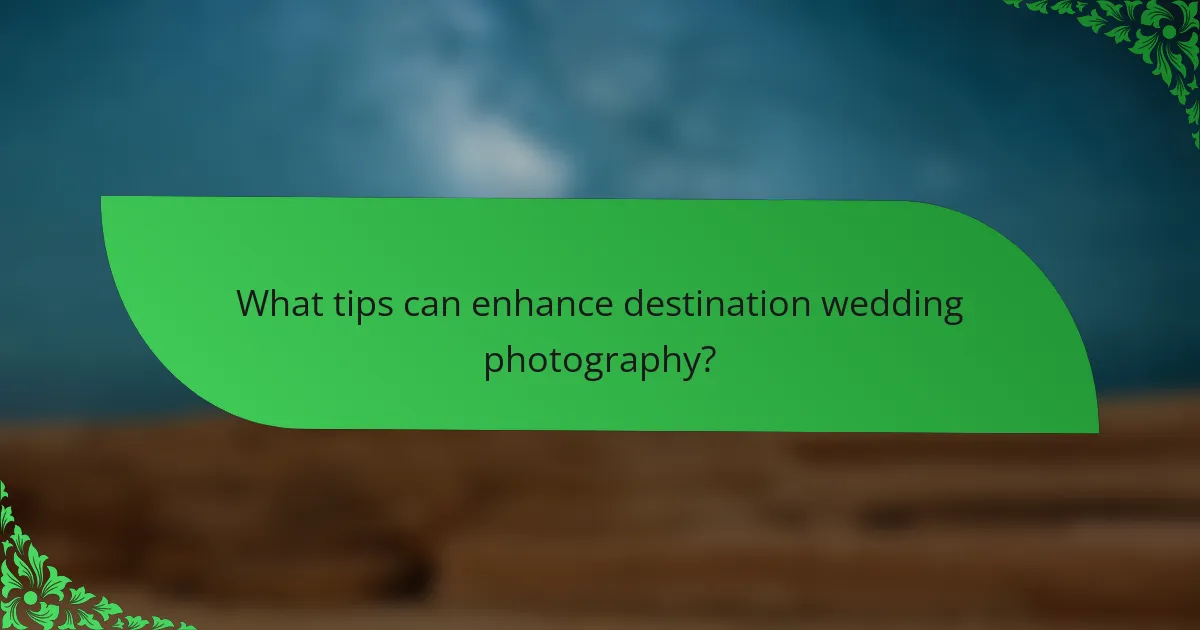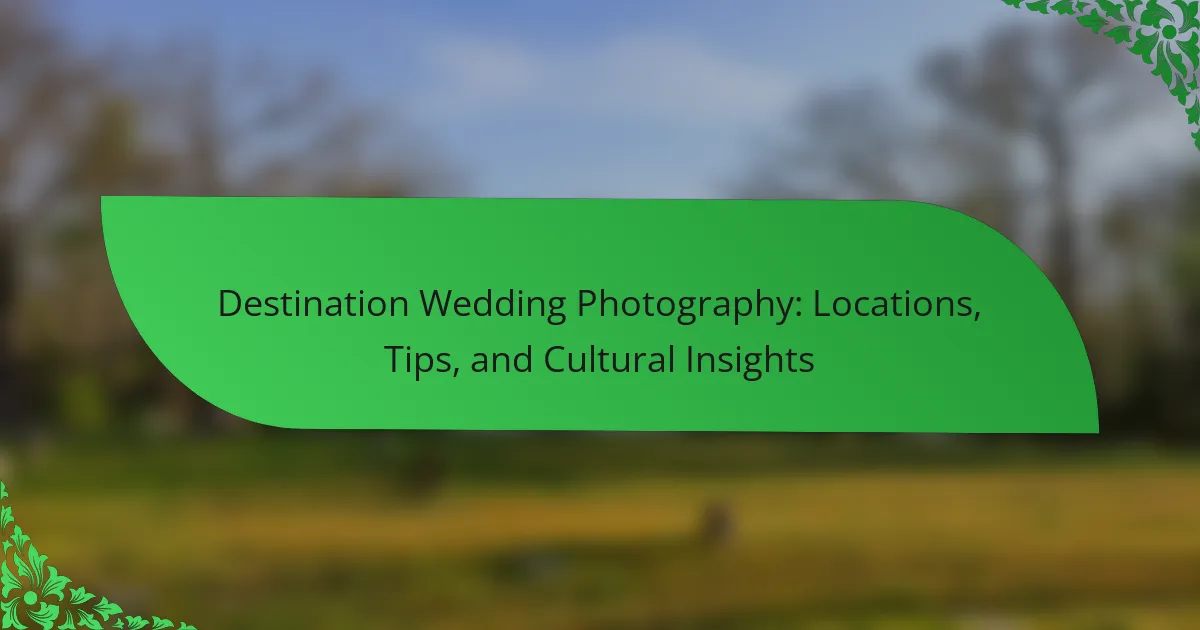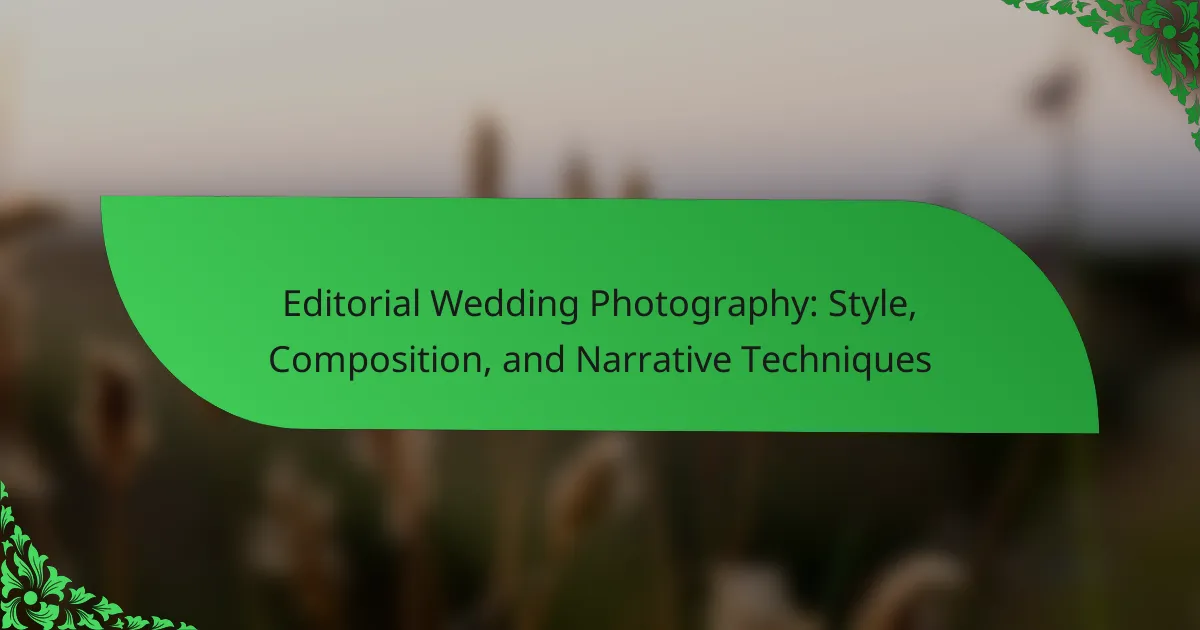Destination wedding photography focuses on capturing weddings in unique or exotic locations, such as beaches, mountains, and historic sites. This genre requires photographers to adapt to varying lighting conditions and landscapes while understanding cultural nuances. With around 25% of weddings in the U.S. being destination weddings, there is a growing demand for skilled photographers who can create stunning visual narratives. The article covers popular locations for destination weddings, tips for utilizing natural light, and the importance of communication with couples to ensure their vision is realized. Additionally, it emphasizes the need for flexibility to adapt to changing weather conditions, which can lead to unexpected and beautiful shots.

What is Destination Wedding Photography?
Destination wedding photography is a specialized genre of photography focused on capturing weddings held in unique or exotic locations. This type of photography often involves travel to picturesque venues, such as beaches, mountains, or historic sites. Photographers in this field must adapt to various lighting conditions and landscapes. They also need to understand cultural nuances in different locations. Destination wedding photography requires strong planning and communication skills. Many couples choose this option for its scenic backdrops and intimate settings. Statistics show that destination weddings have increased in popularity, with around 25% of weddings in the U.S. being destination weddings. This trend highlights the growing demand for professional photographers who can deliver stunning visual narratives of these special events.
How does Destination Wedding Photography differ from traditional wedding photography?
Destination wedding photography focuses on capturing weddings held in unique locations away from the couple’s home. Traditional wedding photography typically takes place in a local venue or [censured]. Destination photographers often incorporate scenic backdrops, such as beaches or historic landmarks, into their shots. In contrast, traditional photographers may focus more on indoor settings and classic poses.
Destination wedding photography requires extensive travel and planning, which can affect logistics. Traditional wedding photography usually involves less travel and simpler arrangements. Additionally, destination photographers often have experience with diverse cultures and customs, which can enrich the storytelling aspect of the photos. Traditional photographers may not have the same exposure to varied cultural practices.
Furthermore, destination weddings often attract smaller guest lists, leading to more intimate photography styles. Traditional weddings usually have larger gatherings, with a focus on group shots. These differences highlight the distinct approaches and considerations in destination versus traditional wedding photography.
What unique challenges do photographers face in destination weddings?
Photographers face several unique challenges in destination weddings. These challenges include logistical issues, such as travel and accommodation arrangements. Photographers must also adapt to unfamiliar locations and varying weather conditions. Communication barriers may arise due to language differences with local vendors. Additionally, photographers often have limited time to scout locations before the event. Cultural differences can affect expectations regarding photography styles and traditions. Lastly, equipment may be restricted by airline regulations, impacting what photographers can bring. Each of these challenges requires careful planning and adaptability to ensure successful outcomes.
What are the advantages of choosing destination wedding photography?
Destination wedding photography offers unique advantages for couples. It captures the essence of a location that holds special meaning. This type of photography often results in breathtaking backdrops. Scenic locations enhance the overall aesthetic of wedding photos. Professional photographers experienced in destination settings can provide creative angles. They understand how to utilize natural light effectively. Additionally, couples often enjoy a more intimate celebration. This can lead to more genuine emotions being captured. Destination weddings typically have fewer guests, allowing for closer connections. Overall, destination wedding photography combines artistry with personal significance.
What are the key elements of successful destination wedding photography?
Successful destination wedding photography relies on several key elements. First, understanding the location is crucial. Photographers must research the venue and surrounding areas. This knowledge helps in capturing unique shots that highlight the destination’s beauty. Second, lighting plays a vital role in photography. Natural light enhances the quality of images. Photographers should plan shoots during the golden hour for optimal lighting. Third, communication with the couple is essential. Discussing their vision ensures the photographer captures their desired moments. Fourth, flexibility is important. Destination weddings can be unpredictable due to weather or logistics. A successful photographer adapts to changing conditions. Lastly, storytelling through images is key. Each photo should convey emotions and the day’s narrative. These elements combined lead to memorable and impactful destination wedding photography.
How important is location selection in destination wedding photography?
Location selection is crucial in destination wedding photography. It directly influences the aesthetic and emotional impact of the photographs. A well-chosen location enhances the couple’s story and reflects their personalities. Scenic backdrops can create stunning visuals that resonate with viewers. For instance, iconic landmarks or natural landscapes provide unique settings. The lighting conditions at different locations can also affect the quality of the images. Furthermore, familiarity with the locale allows photographers to capture the best angles and moments. Ultimately, the right location contributes significantly to the overall success of the wedding photography experience.
What role does cultural context play in destination wedding photography?
Cultural context significantly influences destination wedding photography. It affects the choice of locations, poses, and themes. Photographers must understand local customs and traditions. This knowledge helps capture authentic moments. For instance, Indian weddings often include vibrant colors and rituals. These elements should be reflected in the photography style. Understanding cultural nuances enhances storytelling through images. It also ensures respect for the couple’s heritage. Photographers who adapt to cultural context create more meaningful and personalized wedding albums.

What are popular locations for destination weddings?
Popular locations for destination weddings include tropical beaches, historic cities, and scenic mountains. Tropical beaches like those in Hawaii and the Caribbean offer stunning backdrops. Historic cities such as Paris and Venice provide romantic settings with cultural significance. Scenic mountains, including the Swiss Alps and Rocky Mountains, present breathtaking natural beauty. Each location offers unique charm and ambiance for couples. These destinations are frequently chosen for their picturesque landscapes and memorable experiences.
Which countries are known for their stunning destination wedding venues?
Countries known for stunning destination wedding venues include Italy, Mexico, and Greece. Italy offers picturesque locations like Tuscany and Amalfi Coast. Mexico features beautiful beaches in Cancun and Los Cabos. Greece is renowned for the stunning views of Santorini and Mykonos. Each of these countries provides unique settings that enhance the wedding experience. They are popular choices among couples seeking memorable ceremonies. The combination of scenery, culture, and hospitality makes these countries ideal for destination weddings.
What are the top beach destinations for weddings?
The top beach destinations for weddings include Maui, Hawaii; Cancun, Mexico; and the Maldives. Maui offers stunning sunsets and lush landscapes, making it a romantic choice. Cancun features beautiful turquoise waters and all-inclusive resorts, ideal for destination weddings. The Maldives is known for its private overwater bungalows and pristine beaches, providing a luxurious setting. Other notable mentions are Bora Bora, Fiji, and the Amalfi Coast in Italy, which also attract couples seeking picturesque beach venues. Each of these locations provides unique attributes that enhance the wedding experience.
What unique cultural destinations are popular for weddings?
Unique cultural destinations popular for weddings include destinations like Bali, Santorini, and Jaipur. Bali offers stunning beaches and rich traditions. Santorini is known for its breathtaking sunsets and whitewashed buildings. Jaipur features historic palaces and vibrant colors. These locations provide unique cultural experiences. Each destination has a distinct atmosphere that enhances wedding ceremonies. Popularity stems from their picturesque settings and cultural significance. Couples seek these places for memorable and visually striking weddings.
How can couples choose the right location for their destination wedding?
Couples can choose the right location for their destination wedding by considering several key factors. First, they should identify their desired atmosphere, such as beach, mountain, or urban settings. Next, they must assess the accessibility of the location for their guests. This includes evaluating travel options and accommodation availability. Couples should also consider the local climate during their wedding date. Additionally, they should research local laws and regulations regarding weddings. Budget constraints play a crucial role in location selection. Couples must factor in venue costs and any additional expenses. Lastly, they should explore cultural significance and local traditions that may enhance their wedding experience. By evaluating these factors, couples can make an informed decision for their destination wedding location.
What factors should be considered when selecting a wedding location abroad?
Consider the legal requirements for a wedding abroad. Each country has different laws regarding marriage. Research the documentation needed for a legal ceremony. Accessibility for guests is crucial. Ensure the location is reachable for family and friends. Climate plays a significant role in planning. Check the weather patterns during your chosen date. Venue options should align with your vision. Look for places that offer the ambiance you desire. Budget constraints must be considered. Understand the costs associated with travel and accommodations. Cultural customs can influence your wedding experience. Familiarize yourself with local traditions and practices. Lastly, availability of vendors is essential. Confirm that photographers, caterers, and planners are accessible in the area.
How do seasonal changes affect destination wedding locations?
Seasonal changes significantly impact destination wedding locations. Weather conditions, such as temperature and precipitation, vary with the seasons. For example, tropical locations may have a rainy season, affecting outdoor ceremonies. In contrast, winter months can offer picturesque snowy backdrops in mountainous regions. Seasonal tourism trends also influence venue availability and pricing. Popular destinations may be crowded during peak seasons, while off-peak times can provide more intimate settings. Additionally, local flora changes with seasons, enhancing the aesthetic appeal of wedding photography. Therefore, couples must consider these factors when selecting a destination for their wedding.

What tips can enhance destination wedding photography?
Use natural light to enhance destination wedding photography. Natural light creates soft, flattering images. Aim for golden hour, which occurs shortly after sunrise and before sunset. This time provides warm, diffused light. Scout locations beforehand to identify the best spots. Unique backdrops can add character to the photos. Consider using local flora and landscapes for authenticity. Incorporate candid moments to capture genuine emotions. These often result in the most memorable images. Communicate with the couple to understand their vision. This ensures the photos align with their expectations. Lastly, be adaptable to changing weather conditions. Flexibility can lead to unexpected, beautiful shots.
How can photographers prepare for a destination wedding shoot?
Photographers can prepare for a destination wedding shoot by conducting thorough research on the location. Understanding the venue’s layout helps in planning the shot list effectively. Photographers should also check the local weather conditions for optimal shooting times. Creating a detailed timeline ensures that all important moments are captured.
Communicating with the couple about their preferences is essential for personalized shots. Photographers should scout the location in advance to identify the best spots for photography. Packing essential gear, including backup equipment, is crucial to avoid any technical issues.
Familiarizing themselves with local customs and regulations can prevent potential disruptions. Having a contingency plan for unexpected situations ensures a smooth shooting experience.
What equipment is essential for destination wedding photography?
Essential equipment for destination wedding photography includes a high-quality camera, versatile lenses, and external flash. A full-frame DSLR or mirrorless camera captures high-resolution images. Lenses such as a 24-70mm and a 70-200mm provide flexibility for various shots. An external flash enhances lighting in challenging conditions. Additionally, a tripod stabilizes images during low-light scenarios. Backup memory cards ensure no loss of important photos. A camera bag protects equipment during travel. Finally, a portable reflector aids in managing natural light. This combination of gear is crucial for capturing memorable wedding moments.
How can photographers build rapport with couples in a foreign location?
Photographers can build rapport with couples in a foreign location by establishing trust and understanding. Engaging in pre-shoot conversations helps to break the ice. Photographers should ask about the couple’s story and preferences. This personal connection fosters comfort during the shoot. Familiarizing themselves with local customs enhances the experience. It shows respect and appreciation for the couple’s culture. Using a friendly demeanor can ease any tension. Providing clear communication about the process builds confidence. These strategies contribute to a positive and memorable photography experience.
What are some common pitfalls to avoid in destination wedding photography?
Common pitfalls to avoid in destination wedding photography include inadequate planning, poor communication, and lack of local knowledge. Inadequate planning can lead to missed moments and unpreparedness for weather conditions. Poor communication with the couple can result in misunderstandings about their expectations. Lack of local knowledge may hinder the photographer’s ability to find the best locations and lighting conditions. Additionally, not considering travel logistics can cause delays and stress on the wedding day. These factors can significantly affect the quality of the photographs and the overall experience for the couple.
How can photographers handle unexpected weather conditions?
Photographers can handle unexpected weather conditions by being prepared with appropriate gear. This includes using weather-resistant camera equipment and protective covers. Carrying extra batteries is essential, as cold weather can drain them quickly. Photographers should also scout locations in advance to identify sheltered spots. Having a flexible shooting plan allows adaptation to changing conditions. Utilizing natural light effectively can enhance photos even in overcast weather. Lastly, embracing the weather can lead to unique and memorable shots. Photographers often find that unexpected conditions can create dramatic effects, enhancing their work.
What should photographers do to manage time effectively during the event?
Photographers should create a detailed timeline before the event. This timeline should outline key moments, such as the ceremony and reception. They must communicate this timeline with the couple and wedding planner. Setting specific time limits for each segment helps maintain focus. Photographers should also scout locations in advance. Familiarity with the venue allows for efficient movement between spots. Prioritizing shots based on importance ensures essential moments are captured. Utilizing tools like shot lists can streamline the process. Lastly, staying flexible is crucial, as events may not always go as planned.
What cultural insights should photographers consider for destination weddings?
Photographers should consider local customs, traditions, and attire when capturing destination weddings. Understanding cultural practices enhances the authenticity of the photographs. Different cultures have specific rituals during weddings, such as ceremonies, dances, or blessings. For example, Indian weddings often include vibrant colors and intricate henna designs. Photographers should also be aware of the significance of symbols used in various cultures. This knowledge allows photographers to capture meaningful moments accurately. Additionally, local cuisine and decor can influence the overall aesthetic of the wedding. Being respectful and adaptable to cultural nuances is essential for successful destination wedding photography.
How can understanding local customs enhance wedding photography?
Understanding local customs enhances wedding photography by allowing photographers to capture culturally significant moments. Knowledge of traditions helps photographers anticipate key events during the ceremony. This insight enables them to position themselves effectively for the best shots. For instance, in some cultures, specific rituals occur at precise times. Being aware of these moments ensures that important actions are not missed. Additionally, understanding attire and symbolism can guide photographers in framing shots that reflect cultural nuances. This approach leads to more authentic and meaningful photographs. Ultimately, respecting and integrating local customs enriches the storytelling aspect of wedding photography.
What are the implications of cultural differences on photography styles?
Cultural differences significantly influence photography styles. Various cultures have distinct visual aesthetics and storytelling traditions. For instance, Western photography often emphasizes individualism and candid moments. In contrast, Eastern photography may focus on group dynamics and harmony.
Cultural symbolism also alters photographic content. Certain colors and motifs hold unique meanings across cultures. For example, red symbolizes luck in Chinese culture but can represent danger in Western contexts.
Additionally, cultural practices shape posing and composition. Traditional ceremonies may require specific arrangements that reflect cultural values. This impacts how photographers capture moments, ensuring authenticity and respect for traditions.
Cultural differences also affect post-processing styles. Some cultures prefer vibrant colors, while others may favor muted tones. This variety leads to diverse visual narratives in destination wedding photography.
Understanding these implications is crucial for photographers. It allows them to tailor their approach, ensuring they honor and represent the couple’s cultural background accurately.
What are the best practices for capturing stunning destination wedding photos?
To capture stunning destination wedding photos, focus on natural light and unique locations. Early morning or late afternoon light enhances colors and creates soft shadows. Scout locations beforehand to identify the best backdrops. Use local scenery to infuse cultural elements into the photos. Incorporate candid moments to showcase genuine emotions. Experiment with different angles and perspectives for creative shots. Ensure the couple is comfortable to portray authentic interactions. Lastly, communicate with the couple to understand their vision and preferences. These practices enhance the quality and emotional impact of the wedding photos.
How can photographers utilize natural light effectively in diverse locations?
Photographers can utilize natural light effectively in diverse locations by understanding the quality and direction of light. The golden hour, shortly after sunrise and before sunset, provides soft, warm light ideal for portraits. Photographers should observe how light interacts with the environment. For instance, open areas may produce harsh shadows, while shaded spots can soften light. Reflectors can redirect light onto subjects, enhancing brightness without additional equipment. In locations with variable weather, photographers should adapt by using overcast conditions to create even lighting. Understanding the local landscape helps in finding optimal light angles. Each location has unique attributes that affect light, so experimentation is crucial for capturing the best images.
What techniques can be used to creatively portray the essence of the destination?
Techniques to creatively portray the essence of a destination include using local landscapes, cultural symbols, and authentic interactions. Incorporating natural scenery emphasizes the unique beauty of the location. Capturing traditional attire and customs showcases cultural significance. Utilizing local architecture adds character and context to the imagery. Engaging with local people creates genuine emotional connections. Employing diverse angles and lighting enhances visual storytelling. These methods collectively convey the destination’s personality and charm. Research indicates that visual narratives significantly impact viewer perception and emotional engagement.
Destination wedding photography is a specialized field that captures weddings in unique and exotic locations, requiring photographers to navigate various challenges such as travel logistics, cultural nuances, and lighting conditions. This article explores the differences between destination and traditional wedding photography, highlighting the advantages of choosing scenic venues, popular locations for weddings, and essential tips for capturing stunning images. It also discusses the importance of understanding local customs and the impact of seasonal changes on photography styles, providing valuable insights for both couples and photographers. Key elements for successful shoots, including equipment preparation and effective communication, are also covered to enhance the overall photography experience.



